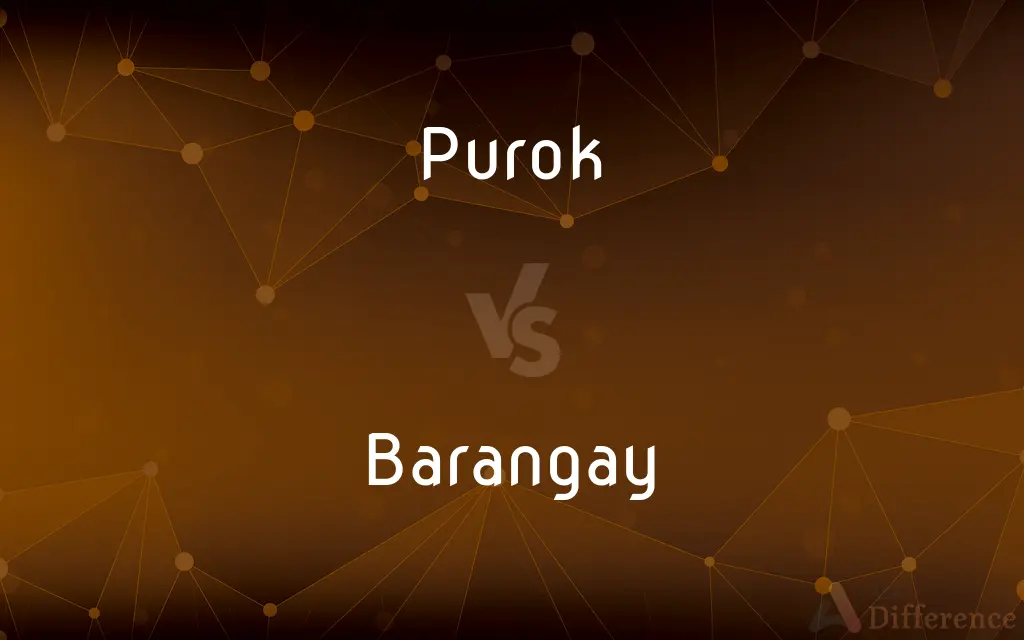Purok vs. Barangay — What's the Difference?
Edited by Tayyaba Rehman — By Maham Liaqat — Updated on April 8, 2024
Purok signifies a smaller unit within a barangay, focusing on localized community management, while a barangay is the smallest administrative division in the Philippines, serving as a primary government and societal unit.

Difference Between Purok and Barangay
Table of Contents
ADVERTISEMENT
Key Differences
A purok is a sub-unit within a barangay, which is the smallest administrative division in the Philippines, typically encompassing a more localized group of homes or families. This subdivision allows for more effective organization and governance at the most local level. On the other hand, a barangay represents the smallest officially recognized form of government in the Philippines, acting as a primary unit of administration, responsible for governance, public services, and community development in its area.
Puroks are designed to facilitate closer community interaction and more detailed management of community services, such as waste collection, street lighting, and neighborhood watch programs. Whereas barangays are responsible for broader governance tasks, including law enforcement, public health, and education services, as well as the implementation of national government programs at the local level.
Leadership within a purok is typically less formalized, often consisting of a purok leader who works voluntarily or is elected by the residents to manage day-to-day concerns and coordinate with barangay officials. In contrast, barangays are governed by an elected Barangay Captain and a council (Sangguniang Barangay) that oversees various committees responsible for different aspects of governance and public welfare.
The establishment of puroks within a barangay enables more efficient and effective governance by breaking down the community into more manageable segments. This system allows for specific needs and issues of smaller areas to be addressed promptly. Meanwhile, the barangay serves as a fundamental administrative unit, with its leaders playing key roles in local government, politics, and community development.
Puroks and barangays both play critical roles in the Philippines' administrative and governance structure, with puroks allowing for targeted local community management and barangays serving broader administrative and governance functions. The relationship between the two is symbiotic, with puroks enhancing the barangay's ability to manage its responsibilities more effectively by ensuring that the needs of all community members are addressed at the most local level possible.
ADVERTISEMENT
Comparison Chart
Definition
A smaller unit within a barangay, focusing on localized community management.
The smallest administrative division in the Philippines, serving as a primary government and societal unit.
Purpose
Facilitates closer community interaction and management of local services.
Responsible for governance, public services, and community development.
Governance
Led by a purok leader, often on a voluntary or elected basis.
Governed by an elected Barangay Captain and Sangguniang Barangay.
Responsibilities
Focuses on day-to-day concerns and coordination of community services.
Oversees law enforcement, public health, education, and implementation of national programs.
Scale
Comprises a localized group of homes or families within a barangay.
Can encompass several puroks, representing a larger community or area.
Compare with Definitions
Purok
A subdivision within a barangay for localized management.
Purok 7 organized a clean-up drive in their area.
Barangay
The primary administrative unit in the Philippines.
Barangay San Antonio launched a health awareness campaign.
Purok
Managed by a purok leader.
The purok leader held a meeting to discuss security measures.
Barangay
Governed by elected officials.
The Barangay Captain initiated a scholarship program for residents.
Purok
Focuses on community-specific issues.
The purok leader coordinated the street lighting installation.
Barangay
Responsible for broad governance tasks.
The barangay council passed a resolution to improve public safety.
Purok
Enhances barangay service delivery.
The barangay used purok feedback to prioritize road repairs.
Barangay
Comprises several puroks.
The barangay organized a sports fest involving all its puroks.
Purok
Facilitates effective local governance.
Purok initiatives have improved waste management.
Barangay
Implements national programs locally.
The barangay facilitated the distribution of government aid.
Purok
A purok (English: district or zone) is a division within a barangay in the Philippines. While not officially considered a local government unit (LGU), a purok often serves as a unit for delivering services and administration within a barangay.A purok is typically composed of twenty to fifty or more households, depending on the particular geographical location and cluster of houses.
Barangay
(Philippines) The smallest local government unit in the Philippines, a subdivision of a city or municipality.
Purok
A district in the Philippines, smaller than a barangay
Barangay
(Philippines) type of boat
Common Curiosities
What is a purok?
A purok is a sub-unit within a barangay in the Philippines, focusing on localized community management and services.
How does a purok differ from a barangay?
A purok is a smaller unit within a barangay, focusing on more localized community tasks, while a barangay is a primary administrative division with broader governance responsibilities.
What is a barangay?
A barangay is the smallest local government unit in the Philippines, responsible for governance and community development in its area.
How are purok leaders chosen?
Purok leaders are usually chosen through community consensus or election, depending on the barangay's practices.
Who leads a purok?
A purok is led by a purok leader, who is often voluntarily elected or appointed to manage local community concerns.
Do barangay officials have jurisdiction over puroks?
Yes, barangay officials have jurisdiction over puroks and work closely with purok leaders to manage community affairs.
What are the responsibilities of a barangay?
A barangay is responsible for local governance, public services, education, health, law enforcement, and implementing national government programs.
What role do puroks play in community development?
Puroks play a critical role in community development by addressing localized issues and enhancing the overall effectiveness of barangay governance.
What is the significance of puroks in the Philippines' administrative structure?
Puroks enhance the administrative efficiency of barangays by ensuring that governance and community services are accessible and tailored to the needs of specific localities.
How do puroks impact the delivery of public services?
Puroks improve the delivery of public services by allowing for more targeted and efficient management of resources and services at the local level.
Can a barangay comprise multiple puroks?
Yes, a barangay typically comprises several puroks, each focusing on specific segments of the community for better management.
Are purok and barangay unique to the Philippines?
Yes, the terms and concepts of purok and barangay are unique to the Philippines, reflecting its local governance structure.
How does governance in a purok contribute to the barangay's objectives?
Governance in a purok contributes by ensuring that the barangay's objectives are met through detailed, localized management and by addressing the immediate needs of smaller community segments.
What challenges do barangays face in managing multiple puroks?
Managing multiple puroks can present challenges in terms of resource allocation, consistent service delivery, and ensuring effective communication and coordination among purok leaders.
Share Your Discovery

Previous Comparison
Function vs. Algorithm
Next Comparison
Vidcaps vs. DidcapsAuthor Spotlight
Written by
Maham LiaqatEdited by
Tayyaba RehmanTayyaba Rehman is a distinguished writer, currently serving as a primary contributor to askdifference.com. As a researcher in semantics and etymology, Tayyaba's passion for the complexity of languages and their distinctions has found a perfect home on the platform. Tayyaba delves into the intricacies of language, distinguishing between commonly confused words and phrases, thereby providing clarity for readers worldwide.
















































